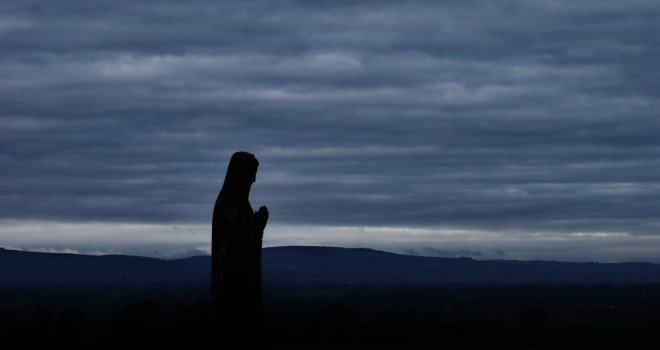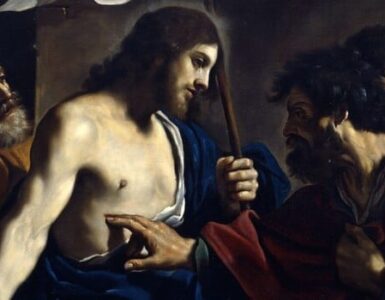The late British professor of linguistics and author, J.R.R. Tolkien has gifted to the world two epic tales: The Hobbit and The Lord of the Rings. These two literary achievements have reshaped the trajectory of fiction since they were first printed in 1937 and 1954, respectively.
As a staunch Catholic, Tolkien quite naturally infused his Christian worldview using an oblique writing style. While he never mentions God, religion or a church, Tolkien references heaven, hell, the sacraments, and countless other customs of Christian piety within these magnificent texts. The author himself writes, “The Lord of the Rings is of course a fundamentally religious and Catholic work.”
During this Marian month of May—traditionally set aside for devotion to the Blessed Mother—it might be edifying to revisit these stories using a Mariological lens:
“Frodo gazed in wonder at this marvellous gift that he had so long carried, not guessing its full worth and potency. Seldom had he remembered it on the road, until they came to Morgul Vale, and never had he used it for fear of its revealing light. Aiya Eärendil Elenion Ancalima! he cried, and knew not what he had spoken; for it seemed that another voice spoke through his, clear, untroubled by the foul air of the pit.” (The Two Towers)
As Frodo confronts Shelob, he furnishes the trinket that was gifted to him by the Elvin Queen, Lady Galadriel. As the fellowship departs from Lothlorien, Galadriel blesses Frodo and offers him a guiding light: “May it be a light to you in dark places, when all other lights go out.” Later, in Shelob’s lair, Frodo raises the phial and cries out: “Aiya Eärendil Elenion Ancalima!” which translates, “Hail Eärendil, brightest of stars!” Similarly, the Blessed Mother, the Star of the Sea, has given to us the rosary as a light in dark places to direct our hearts toward her son, Jesus. Mary’s name in Hebrew is Miryam, meaning “drop of the sea.” The imagery suggests that the Mother of God is the interceding light to all Christians. We pray, “Hail Mary, full of grace!” (Luke 1:28)
Lady Galadriel is a beautiful representation of Mary as Queen of Heaven (Revelation 12:1). Tolkien also invokes the Blessed Mother as one who will battle the evil one:
“A sword rang as it was drawn. ‘Do what you will; but I will hinder it, if I may.’ ‘Hinder me? Thou fool. No living man may hinder me!’ Then Merry heard of all sounds in that hour the strangest. It seemed that Dernhelm laughed, and the clear voice was like the ring of steel. ‘But no living man am I! You look upon a woman. Éowyn I am, Éomund’s daughter.’ … ‘Éowyn! Éowyn!’ cried Merry. Then tottering, struggling up, with her last strength she drove her sword between crown and mantle.” (The Return of the King)
Éowyn perfectly embodies the woman foretold in Genesis 3:15 who will crush the head of the serpent. It is of course Mary’s seed, Jesus Christ, who destroys Satan’s head by His triumph on the Cross. Early Christians understood this prophecy from Genesis as a reference to the Theotokos, meaning the “Mother of God.” She is later seen in Revelation 12:1, physically assumed in heaven, as the Ark of the New Covenant, with the moon under her feet. This final detail from scripture is a clue to how Tolkien will crush the head of one of the greatest serpents in Middle Earth: Smaug.
The Hobbit tells the tale of Bilbo Baggins: a simple hobbit who desires comfort and seems to be unwilling to sacrifice himself for others. Bilbo’s story is a pilgrimage of grace, which demonstrates the power of growing in wisdom and virtue.
During his many adventures with the dwarves, Bilbo is confronted with a series of challenges that are often resolved in supernatural ways. Tolkien alludes to God and to the Christian life throughout the story. For instance: as the company escapes the clutches of captivity from the Elf King, Bilbo dutifully baptizes all of his companions, as he drops them all into water: “I am he that buries his friends alive and drowns them alive again from the water.” They have escaped the clutches of sin through baptism, which saves you. (1 Peter 3:21)
Tolkien also uses poignant imagery to depict God himself. As Bilbo and the company of dwarves approach the secret entrance to the Lonely Mountain, they have a difficult time locating the keyhole. It requires the direct intervention of God to locate the entrance:
“The sun sank lower and lower, and their hopes fell. It sank into a belt of reddened cloud and disappeared. The dwarves groaned, but still Bilbo stood almost without moving … Then suddenly when their hope was lowest a red ray of the sun escaped like a finger through a rent in the cloud. A gleam of light came straight through the opening into the bay and fell on the smooth rock-face … There was a loud crack. A flake of rock split from the wall and fell. A hole appeared suddenly about three feet from the ground. Quickly, trembling lest the chance should fade, the dwarves rushed to the rock and pushed—in vain. ‘The key! The key!’ cried Bilbo.” (On the Doorstep, The Hobbit)
God directly intercedes in the form of the sun like a finger. The ninth-century hymn, Veni Creator Spiritus, poetically describes the Holy Spirit as “the Finger of God’s right hand.” God, in the third person of the Trinity, wants to touch, lead, and guide us. The Light of God also gives us hope in times of struggle. This can be seen in The Lord of the Rings as Frodo and Sam approach the Cross-roads of Ithilian. They walk past a seated statue of a king from old that has been desecrated by orc graffiti. Suddenly, the setting sun casts a convenient ray of light on the statue: “Look!” Frodo cries. “The king has got a crown again!” (The Two Towers) God gave to them the image of the crown of life, as they were undergoing the test. (James 1:12)
As Bilbo and the dwarves delve deeper into the Lonely Mountain, they awoke Smaug. In his anger, Smaug descends to unleash his wrath on the unsuspecting people of Laketown. The dragon will be no match for the Blessed Mother:
“The dragon swooped once more lower than ever, and as he turned and dived down his belly glittered white with sparkling fires of gems in the moon—but not in one place. The great bow twanged. The black arrow sped straight from the string, straight for the hollow by the left breast where the foreleg was flung wide. In it smote and vanished, barb, shaft and feather, so fierce was its flight. With a shriek that deafened men, felled trees and split stone, Smaug shot spouting into the air, turned over and crashed down from on high in ruin.” (Fire and Water, The Hobbit)
Smaug’s weakness is exposed by the moon. Traditional Christianity describes the bi-nary unity of Jesus Christ and the Blessed Mother as represented by the sun and the moon. Jesus is the sun (the Son) – the only true source of eternal Light. Mary is the interceding light to all Christians. She is like the moon, which is lightless, until it reflects a guiding light from the sun. Her intercession is famously described by St. Louis de Montfort: “To Jesus through Mary.”
Tolkien chooses to use the light of the sun through the moon (Jesus through Mary) to crush the head of Smaug. He is ultimately slain by the darkness of his own heart – the absence of light in the weak spot of his own chest. The Light of God’s presence disperses the shadows of darkness.
Sun and moon; sing praise to him and highly exalt him forever!
(Daniel 3:62)
✠
Photo by Alex Gindin on Unsplash













